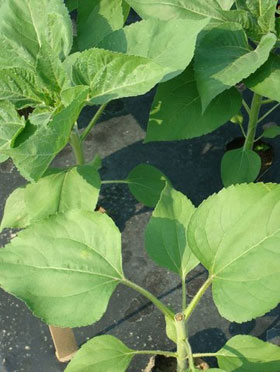
Helianthus annuus
Propagation:
- Since sunflowers can be easily grown outside, high tunnel production of the crop only makes sense early in the season, before field production is possible.
- Early sunflowers should be transplanted from greenhouse-started seedling trays.
- Given the large size of sunflower seeds, 72- to 144-cell trays are best for seedling production.
- In moderate greenhouse temperatures (65-75 F), expect to transplant in less than 3 weeks.
- Delayed transplanting of the fast-growing seedlings will result in tall, weak plants that may have impaired growth after transplanting.
- Direct seeding in late summer for a fall crop may take advantage of frost protection afforded by the high tunnel.

Growing:
- The modern pollen-less hybrids have growth duration from sowing to harvest of between 55 to 75 days when started in early spring.
- Flower stalk and head size are directly dependent on spacing; for head diameter of 4 to 5 in., plant seedlings 6 x 6 in. in a 4-foot bed, or use a 9 x 9 in. spacing, with two seedlings per hill.
- Pinching out the plant tip after 4 leaves have expanded will double or triple flower number per plant, but these will be small, unless spacing is widened to 12 x 12 in.
- For early high tunnel planting in milder zones (Zones 6 and 7), the short daylength in mid-March will cause early flowering of some varieties such as ‘Sunrich Orange’. These plants will flower early on small stalks, and will show excessive numbers of secondary buds.
- View .pdf of sunflower variety sensitivity to day length.

Varieties:
- For use as cut flowers, choose varieties that do not produce pollen. These do not stain their surroundings when placed in a vase in the home.
- There is now a large range of flower colors, sizes, degree of branching, earliness available with pollen-less characteristics.
- The most common sunflower colors are orange petals surrounding a dark brown disk, but disk color can also vary to green and gold.
- Varieties that produce only a single stem usually flower over a short period of time, after which the tunnel space can be used for other crops. Branching types can be harvested for several weeks as branches come into flower.
Postharvest Handling:
- Sunflowers are generally harvested as cut flowers when the flower is just opening, and the ray flowers are perpendicular to the flower disk.
- The flowers should last at least a week in water at room temperature.
- There are big varietal differences in flower life after harvesting, and these relate to flower color. The standard orange types tend to be long-lived. Varieties with dark flower color, or with dark petal bases tend to shed petals in less than a week.
- Short vase life is also related to premature petal loss when flowers are roughly handled at harvest.
- Harvesting flowers during middle of the day may lead to flower wilting. These should be recut when flowers have been moved to a shaded environment.
For more information, see:
- Flower seed catalogs
- Armitage, A.M. and J.M. Laushman. 2003. Specialty Cut Flowers, 2nd Edition. Timber Press, 586 pp. Available through ASCFG


